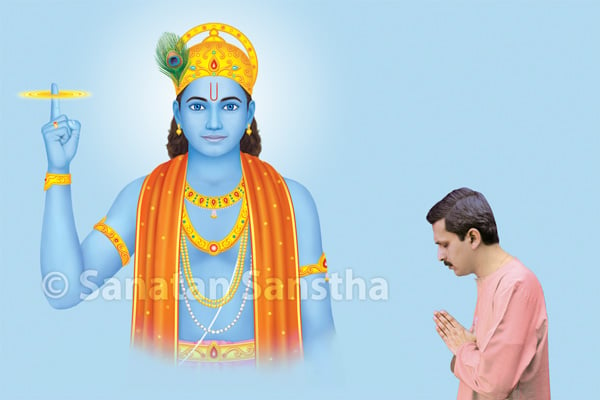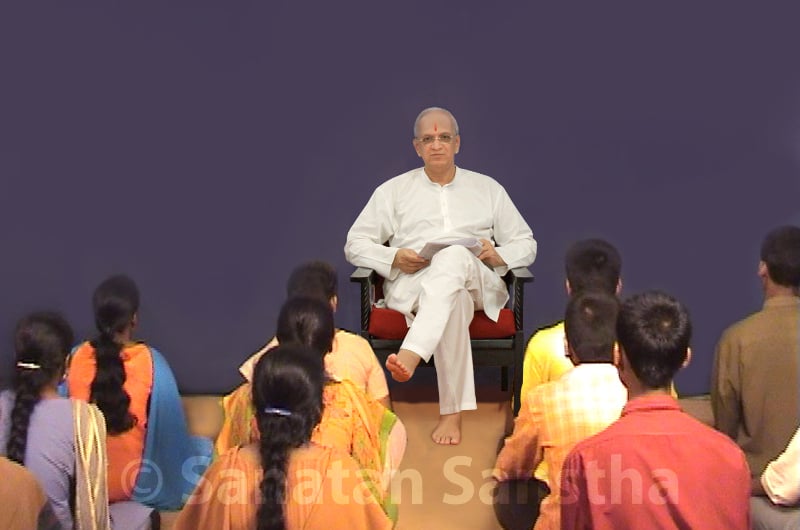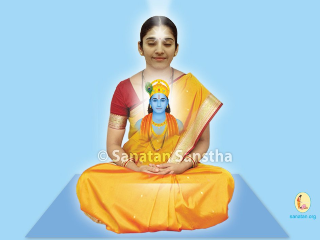Saint Tukaram Maharaj says in one of His hymns, “A devotee’s duty is to have singular bhav towards God. The true secret of devotion is to have this bhav with a firm resolve constantly. Devotees should have firm faith in God, without expecting anything in return. They should not wish for the support of anyone else. God should be their sole support.” Saint Tukaram says that He has not heard of a devotee who has such a bhav and has been ignored by God.
All the same, devotees of God face certain obstacles in awakening of bhav. In this article the obstacles faced by an individual in awakening of bhav and the various efforts that can be undertaken, in order to awaken it have been discussed.
1. Obstacles in awakening bhav
The main obstacles in awakening of bhav are ignorance, doership, ego and personality defects.
1 A. Ignorance
Ignorance is related to the form and qualities of God and His mode of functioning.
1 B. Doership
Doership pertains to the feeling that different incidents in life occur due to someone else or oneself and not due to God.
1 C. Ego
Ego is the feeling that ‘I am distinct from God’; this is the greatest obstacle in awakening of bhav. The more the ego, the less are the chances of developing bhav.
1 D. Personality defects
Defects in personality also prove to be an obstacle in awakening of bhav. Sometimes, benevolent subtle energies from the Bhuvalok (Nether region) who help seekers, project thoughts about bhav or sattvik (Sattva-predominant) thoughts, but they cannot be imbibed due to excessive defects in personality. Once these obstacles are destroyed in the true sense of the term, the others can be overcome quite easily. Efforts made to overcome these obstacles stepwise are attempts to awaken bhav.
2. Stages in the efforts made to awaken bhav
2 A. Bhav-nirmiti (Generation of bhav)
Generation of bhav in a seeker lacking in it is next to impossible and can occur only with the grace of the Guru.
2 B. Bhavjagruti (Awakening of bhav)
This is the process of awakening the dormant bhav within a seeker.
2 C. Bhav-vruddhi (Enhancing of bhav)
These are attempts made to enhance the existing bhav.
3. Various actions to awaken bhav in an individual
To awaken bhav rapidly, initially one needs to make constant efforts at the level of the mind and intellect. Various actions in this context are given here.
3 A. Ritualistic worship, singing hymns, etc.
To develop bhav towards a particular Deity, first one has to develop love for that Deity. Worship of its Sagunn (with attributes) form by performing ritualistic worship, singing hymns, etc. helps develop love for the Deity faster than chanting, that is worship of its Nirgun (without attributes) form. That is precisely why ritualistic worship, singing Arati before a Deity, etc. are beneficial for awakening of bhav in the initial stages. Recitation of verses and hymns are means of glorifying a Deity. Since God likes to be praised and is compassionate, if hymns and verses are sung with bhav, He is appeased.
3 B. Prarthana (Prayer)
3 B 1. Origin and meaning
The word ‘prarthana’ is derived from two words ‘pra’ and ‘artha’, meaning pleading fervently. In other words, it is asking God for something with intense yearning. Prayer includes respect, love, pleading and faith. Through a prayer, a devotee expresses his helplessness and offers the doership of the task to God.
3 B 2. Benefits accrued at the level of action, thought and attitude
-
Action : As a consequence of the prayer, an action is performed with bhav and less errors are committed. Thus, seva (service) unto God or the Guru occurs as per His expectation.
-
Thought : So long as the mind is active, thoughts will continue. They pose an obstacle to dissolution of the mind. Useless thoughts also cause wastage of energy. Prayer is an extremely useful tool to prevent this. Prayer reduces worry and enhances contemplation.
-
Attitude : A prayer made with bhav initiates the process of contemplation upon prayer within a seeker, and this assists him in becoming introverted.
3 B 3. Types of prayers
-
Sakam (with expectation) prayers : These are made for fulfilment of worldly desires, for example wealth, progeny, worldly pleasures, etc.
-
Nishkam (without expectations) prayers : These prayers mean surrendering oneself unto God or the Guru without any objective. A prayer made in the context of spiritual progress or the Guru’s mission is always of this type.
In the former, the one praying remains extroverted; while in the latter, one becomes introverted. A prayer with expectations is inferior, while that made without expectations is superior.
Vyashti (individual) prayer is one which is made to augment one’s individual sadhana (Spiritual practice). Initially a seeker should make this kind of a prayer. Once the prayer occurs with bhav, the seeker can do samashti (society) prayer for other seekers and the society at large, for example for Dharmaprasar (propagation of Dharma). This prayer is for the sake of society. Such a prayer inculcates pervasiveness in a seeker. He begins to feel love for others and his samashti sadhana is enhanced.
3 C. Gratitude
3 C 1. Meaning
God is the creator of the Universe. We too are a part of the Universe. Therefore, both, the Universe and we were created because of God. All events in the Universe followed thereafter. These include me, my happiness and unhappiness, intellect, actions, my family, country, religion, sadhana, etc. Thus, whenever one thinks about the self and / or the world, unconsciously having awareness of God or one of His forms and offering the credit for even this awareness to God, is termed as gratitude. Prayer is actually a synonym for surrender. This act of surrender is complete only after expressing gratitude. The Guru Himself is God for a seeker who is blessed by the grace of a Guru, or for one who is practicing Spirituality according to Gurukrupayoga. Hence, it is natural for him to have more gratitude towards the Guru.
3 C 2. Importance
-
The other meaning of prayer is surrender, and the process of surrender is not complete without expressing gratitude.
-
Reduction in ego : Gratitude is an instrument of offering the doership of an act to God / the Guru; hence it helps in reducing the ego. Often seekers forget to thank God for anything occurring as wished in a prayer or after deriving Anand (Bliss) from rendering seva. A seeker can also develop subtle ego about getting spiritual experiences or experiencing Anand. It is, therefore, important to offer the credit for a spiritual experience or the experience of Anand to the Guru.
-
In expressing gratitude, one offers the result of an action unto God. Since the result of the action is sacrificed, the action becomes an akarma-karma and no give and take account is generated. Thus, the chances of a seeker getting trapped in the cycle of birth and death are reduced.
3 D. Chanting
According to the Path of Devotion, this is the very foundation of sadhana. God’s Name is God Himself. That is why, the easiest mode of being in constant communion with God is to chant continuously. One may get the impression that one develops bhav for God by being in constant communion with Him through the chanting of His Name. Often however, chanting occurs just for its sake, without spiritual love for God. This kind of chanting does not help much in developing bhav for God. That is just why, chanting should be done with bhav.
3 D 1. Importance of chanting with bhav
-
Only if chanting is done with bhav does it reach God.
-
Chanting done with bhav provides protection from negative energies.
3 D 2. Efforts required to chant with bhav
-
A prayer should be made unto the Guru / God to make one chant with bhav.
-
Just as one thinks repeatedly of someone he/she loves or something he/she likes and very easily without any effort (for example, a lover thinks of his beloved or a mother of her child), so also the mind should be conditioned to love God. Once one begins to like or love God, he/she remembers God’s Name easily and experiences Anand on repeating (chanting) it. Later, chanting becomes a way of life.
-
Imagining God’s form time and again makes it easier to love Him. That is why, while chanting, if possible one should place a picture of the Deity within one’s visual range. To make the atmosphere more sattvik, one should affix Name-strips of Deities in the room where he/ she is chanting.
-
One should have a bhav that God / Guru is getting the chanting done.
-
One should have a bhav that God’s Name is a protective sheath against all evil.
-
If one uses an implement such as a japamala to chant, considering it to be a Deity, then one should offer obeisance to it before commencing the chanting.
3 E. Practising Navavidha Bhakti (Nine types of Bhakti)
The aim of a seeker following the Bhaktimarg (Path of Devotion) is to generate intense devotion unto God. To achieve this, it is beneficial to put into practice various types of Navavidha Bhakti namely,
-
Shravan : This form of devotion includes listening to the qualities, victories and glory of God with faith. It also means listening to the Guru’s teachings (knowledge).
-
Kirtan : Singing the praises of God amounts to this kind of devotion. Sharing with people the knowledge one has gained by listening to the Guru’s teachings and inspiring them to behave as per the Guru’s expectations is a devotion of this kind.
-
Smaran : Constant contemplation upon the Name – virtues – leela (Divine play) of God and remaining engrossed in them is this type of devotion. This includes constant remembrance of the gross form of the Guru or God, through a picture / Idol and that of His subtle form, through chanting. If one has a bhav that every breath one takes, every task that one has performed throughout the day has been possible only because of God or that one is living every second only because of God, then one will remember Him throughout the day. This is the true expression of this devotional form. Kunti from the Mahabharat had asked for unhappiness so that she would remember God throughout the day. However, without asking for unhappiness if one attempts as above, then this devotion will develop quickly.
-
Padsevan : In this form of seva, one practically serves the Holy feet of God or performs ritualistic worship of His feet. Seva unto the Guru’s feet means having a bhav that, ‘I am a servitor of God’. A Guru has greater attachment to a disciple who worships His subtle form, that is, the Guru Principle than one who worships only His gross form. Propagation of the Guru’s mission in the best possible way is true seva unto the Guru’s feet.
-
Archan : Puja (Ritualistic worship) of God with devotion and respect is known as archan. Installing a picture of the Guru in the temple at home or worshipping Him mentally are incorporated in this kind of devotion.
-
Vandan : This form of devotion constitutes meditating upon God after completely surrendering unto Him. This includes praying with bhav, so that the prayer reaches God.
-
Dasya : In this form of devotion, the devotee considers God to be his father, mother, everything and himself to be God’s son or servitor. Deity Hanuman is an excellent example of this type of devotion.
-
Sakhya : In this form of devotion, a devotee believes God to be his friend who shares his happiness and unhappiness. Therefore, no barrier of any kind exists between the two. As bhav towards the Guru grows, there is a corresponding growth of respect and gratitude for Him. This makes it difficult to view Him as a friend. Only a rare seeker with a spiritual level of more than 60% is capable of remaining devoted in this way. Devotion of Arjun towards Shrikrushna is an unparalleled example of this.
-
Atmanivedan : This devotion is the ultimate and supreme step in the Path of Devotion. Here, the devotee explicitly narrates everything good or bad, external or internal to God and surrenders completely unto Him. One should narrate daily to the Guru about everything, all of one’s actions, obstacles faced in one’s sadhana, doubts in the mind, etc.
Among these, the first three types help generate faith, the next three are associated with the Sagunn form of God and the last three are internal bhavs.
3 F. Seva (Service unto the Absolute Truth)
To awaken progressive bhav for God or the Guru through the medium of seva, one has to make efforts on the following three planes – Action, Thought and Attitude
Action
Every action can be performed in the following four ways –
-
Seva : Rendering seva merely with the gross body.
-
Complete seva : Carrying out actions with the help of the physical body, mind as well as intellect.
-
Absolute seva : Carrying out actions by surrendering the mind, intellect and ego at the Guru’s feet, that is, not taking doership for one’s actions.
-
Seva of the Guru : Expressing gratitude after completion of seva which is rendered by offering the mind, intellect and ego at the Guru’s feet, and as per His expectations.
Thought
This is the inspiration behind an act; for example, if thoughts are sattvik, then the actions resulting from them are sattvik too.
Attitude
Trying constantly through action and thinking of rendering seva with bhav gradually makes seva possible with bhav, and it gets integrated into one’s attitude. To inculcate this attitude in the self as soon as possible, besides seva unto the Guru and His mission, one should view everything that one does in day-to-day life as seva and make an attempt to do it with bhav.
3 G. Satsang
Satsang means ‘Company of the God Principle’. ‘Sat’ refers to Sattva predominance. Awakening of bhav occurs rapidly in a sattvik environment. It is faster in the company of Saints than in that of seekers.
3 H. Sacrifice
Offering something to God or the Guru is sacrificing. A true disciple is one who sacrifices his body, mind, wealth and even his life for the sake of the Guru. Awakening of bhav occurs faster in such a seeker.
3 I. Priti
Love being an emotion, is not a part of bhav. Priti however is a component of bhav. The basic difference between love and spiritual love is the presence and absence of expectation respectively. Generally, in worldly life, one expects something or the other from the individual one loves. Spiritual love on the other hand loves every creation of God, without any expectation. Sadhana helps in the generation of spiritual love.
3 J. Learning
His Holiness Bhaktaraj Maharaj has said, “Only the curious are deserving of knowledge”. One should constantly learn to generate bhav in oneself. One can learn to enhance bhav through study, spiritual experiences obtained by oneself and of others, from other seekers having bhav and Saints. It is more beneficial to learn from seekers who have bhav, and Saints. Since it is not possible for everyone to learn this from Saints, it is more practical to learn it from seekers who have bhav. If one is motivated to learn, then God too teaches through different mediums.
3 K. Attempts to awaken bhav
while performing worldly tasks, besides sadhana
Worldly actions, the attitude towards the results obtained from them and the experiences obtained while performing these actions are useful from the viewpoint of awakening bhav. In the beginning, there is a qualitative difference between actions performed as sadhana and those performed in worldly life. Hence, at first it is easier to awaken bhav through actions performed with respect to sadhana, like puja, Arati, chanting, satseva, etc. Will even a seeker who is full time into sadhana be able to perform these tasks continuously throughout the day ? Certainly not; because, in day-to-day life he has to perform personal tasks such as bathing, taking treatment for an illness, doing household chores, caring for ill family members, etc. These restrict his actions pertaining to sadhana. Similarly, if attempts to awaken bhav only during actions related to sadhana are made, then it will pose a restriction to awakening of bhav. Hence, one should perform every task as sadhana or with the bhav that, ‘I am the servitor of the Guru’; then the entire process of awakening bhav will be enhanced.
Reference : Sanatan Sanstha’s Holy Text on ‘Spiritual Practice for awakening Spiritual Emotion’.






 Vyashti and samashti bhav
Vyashti and samashti bhav Why is it essential for yearning and bhav to be linked for rapid spiritual progress?
Why is it essential for yearning and bhav to be linked for rapid spiritual progress? Efforts to be undertaken to awaken bhav
Efforts to be undertaken to awaken bhav Why is Sharanagatbhav superior to Krutadnyatabhav?
Why is Sharanagatbhav superior to Krutadnyatabhav? Progressing from expressed to unexpressed bhav
Progressing from expressed to unexpressed bhav